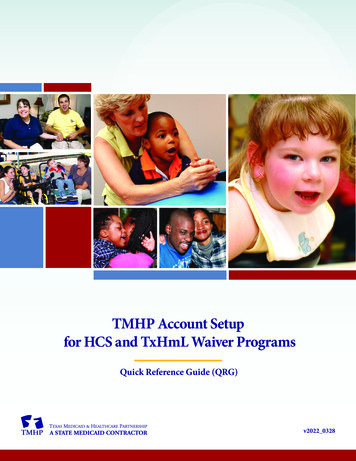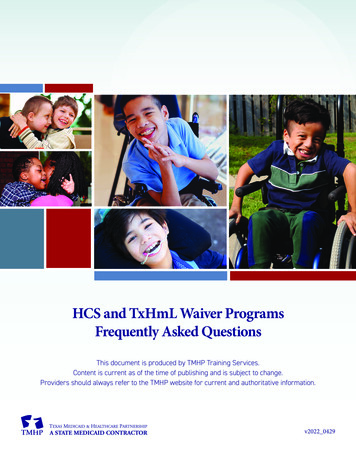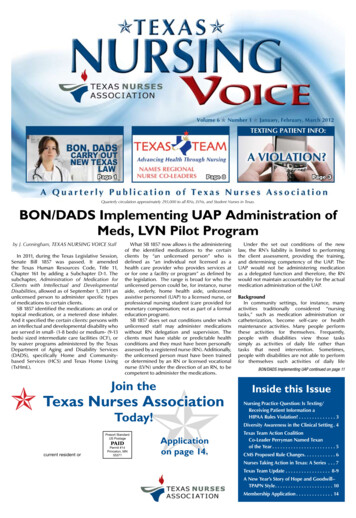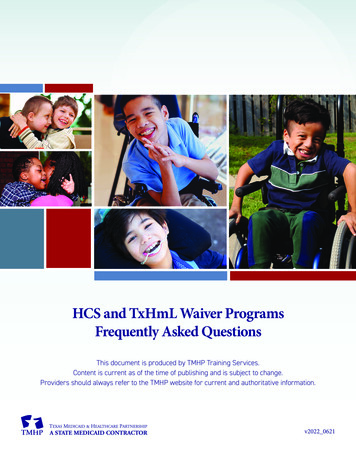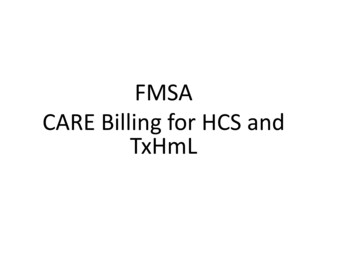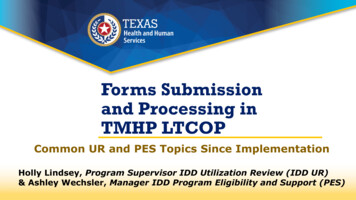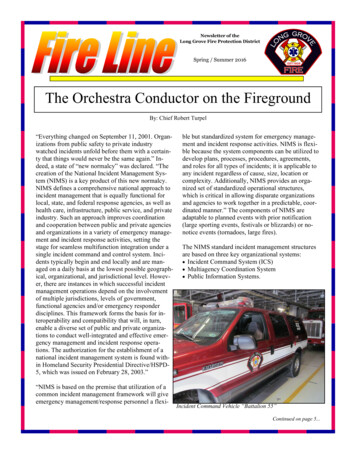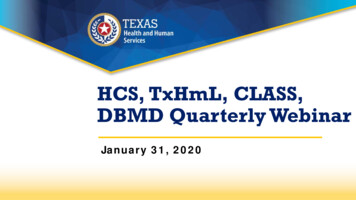
Transcription
HCS, TxHmL, CLASS,DBMD Quarterly WebinarJanuary 31, 2020
AttendantTrainingsLauren Chenoweth, LMSWHHSC Policy Advisor, Medicaid/CHIPJanuary 2020
Agenda Why training? Available trainings Resources and Contacts
Why training? A 2014 DADS survey of community attendantsfound that attendants wanted additional training. Training in general increases employee jobsatisfaction, motivation, and morale. Workers who aren’t properly trained maybecome frustrated at their inability to perform ata high level, leading them to look elsewhere fora job or simply settle for mediocre performance.
Why training? Employee training and development provides youwith a pool of skilled and knowledgeable peoplewho can move up in the organization and fillcritical jobs and perform critical functions. Training helps the employees to recognize safetyhazards and correct them. It enables them to understand best safetypractices and expectations.
Available Training Topics Mental Health Employment Direct Service Workerspecific Benefits Person CenteredThinking Abuse, neglect andexploitation Positive BehaviorManagement Support Children Aging Diagnosis specific Trauma Informed Care Program Specific
Mental Health Training The Mental Health Wellness for Individualswith Intellectual and DevelopmentalDisabilities (MHW-IDD) e-learning trainingseries teaches about integrated approaches forworking with people who have IDD and cooccurring behavioral health needs. Intended for direct service workers and healthcareproviders (HCPs) who provide support forindividuals with IDD and co-occurring behavioralhealth challenges.
Mental Health TrainingModules Co-occurring Disorders: IDD and Mental Illness Trauma-informed Care for Individuals with IDD Functional Behavior Assessment and Behavior Support Overview of Genetic Syndromes Associated with IDD Overview of Medical Diagnoses Associated with IDD
Mental Health TrainingModules(cont.): Putting It All Together: Supports and Strategies for DirectService Workers Integrated Healthcare for Individuals with IDD – for HCPs Communicating with Individuals with IDD – for HCPs Trauma-informed Care for Clinical Providers – for HCPs
Mental Health TrainingTraining videos: Stigma and Mental Healthhttps://www.youtube.com/watch?v 0UF6FumfxR8&list PLJE6pz0haTBoJG8vDhDD7d67CleK6xMx3&index 3&t 0s Behavioral Health Support in the Communityhttps://www.youtube.com/watch?v rbLD50TePAE&list PLJE6pz0haTBoJG8vDhDD7d67CleK6xMx3&index 4&t 0s Behavioral Health Treatment for Mothershttps://www.youtube.com/watch?v Dkpu1smVXuA&list PLJE6pz0haTBoJG8vDhDD7d67CleK6xMx3&index 5&t 0s The PASRR Processhttps://www.youtube.com/watch?v 8wv30d9UysE&t 0s&list PLJE6pz0haTBoJG8vDhDD7d67CleK6xMx3&index 2
Mental Health TrainingTraining Videos(cont.): The PASRR Benefithttps://www.youtube.com/watch?v YInfCr3p64&list PLJE6pz0haTBoJG8vDhDD7d67CleK6xMx3&index 6&t 0s Hiring People With Disabilitieshttps://www.youtube.com/watch?v L95vBId5Cl0 Assistance in the Community for Complex Medical Needshttps://www.youtube.com/watch?v 9VYTWnO8qM&feature youtu.be Transitioning from a State Supported Living Center intothe Communityhttps://www.youtube.com/watch?v VK7Bjhq1yUQ
Mental Health Training Services Available in the Community for Veteranshttps://www.youtube.com/watch?v NVIphMdgJuY YouTube playlist related to behavioral health:https://www.youtube.com/playlist?list PLJE6pz0haTBpkSlOzQiuEab-taYRFSNX5.
Direct Service WorkerTraining Modules 6-part eLearning series designed for direct serviceworkers (DSW) and others who provide qualitypersonal assistance to individuals with disabilities,older individuals, or anyone who receives directcare services. Each module, focuses on various aspects of carefor the individual, including mental wellness,positive supports, and prevention. Each module is approximately 20-30 minutes inlength and the series takes 2-3 hours to complete.
Direct Service WorkerTraining ModulesUnderstanding Dementia and Alzheimer’s Disease. How to approach and deescalate confrontational behavior How to recognize illness or injury in an individual whohas difficulty communicating Effective means of communication How to support connections with family, friends, andothers.
Direct Service WorkerTraining Modules (cont.)The Art of effective Communication and ConflictResolution. How to identify, understand and approach typicalbehavioral repertoire Understand the difference between a challengingbehavior as a form of communication versus a sign ofmental illness Understanding how to assess and get necessaryinformation regardless of a person’s style ofcommunication, or lack of ability to communicate.
Direct Service WorkerTraining Modules (cont.)Rendering Personal Care, Prevention andContainment of Communicable Disease. How to decrease the probability of contractinginfectious diseases Help contain an active communicable diseasewhen providing personal assistance or care The importance of active participation on theindividual’s treatment team.
Direct Service WorkerTraining Modules (cont.)Managing and Preventing Challenging orAggressive Behaviors. Evidence based and best practices regardingappropriate interventions to approach anddeescalate confrontational behavior including: Recognizing the signs that signal when abehavior may be a form or communication and When it may be a sign of serious mental illness The importance of active participation on theindividual’s treatment team.
Direct Service WorkerTraining Modules (cont.)Mental Health and Substance Use. How to provide personal assistance and care toindividuals: Actively experiencing behavioral health issues Are in the recovery process through educationon basic mental health diagnoses and substanceabuse disorders Some universally appropriate evidence informedinterventions The importance of active participation on theindividual’s treatment team.
Direct Service WorkerTraining Modules (cont.)Teaching some Caring for the Caregiver The importance of, and ways to ensure, personalphysical and mental well-being when providingpersonal assistance and care to others, including: Recognizing signs of emotional, mental, andphysical exhaustion Action steps that can be taken to amelioratesymptoms.Found index.php?categoryid 31
Person Centered Thinking se/index.php?categoryid 7 Other PCT training ers/personcentered-planning-pcp-training-providers PCT resourcesPersonCenteredPlanning@hhsc.state.tx.us* If you are seeking this training to meet program requirements please seeyour program specific guidance or reach out to the policy specialist for thatprogram to ensure compliance.
Children Texas A&M Agrilife Extension offers many trainingsrelevant to children with special needs. Some have small costs but many on this topicare me Including-Children-with-Special-Needs The ECI resources page offers links to manyreliable sources of information applicable eguidecentral-directory
ChildrenTexas Health Steps TrainingFree online training on topics applicable to children such as: Childhood depression Anxiety ADHD Trauma Substance abuse Dental care Fetal alcohol spectrum Congenital heart disease Diabetes.https://www.txhealthsteps.com/courses
AgingCenter for Excellence in Aging Services and Long TermCare - modules designed for direct care workers are inPhase I, Phase IV, and Phase V: Phase 1: Anti-Psychotic Drug Reduction Issues Phase 2: Advanced Geriatric Practice Phase 3: Transition To Practice Phase 4: Intellectual and Developmental Disabilities Phase 5: Infection Control and Prevention Phase 6: Social Determinants of Health with Agehttp://www.utlongtermcarenurse.com/
AgingHHSC Quality Monitoring Program Training The trainings here are focused on aging andnursing facilities. However, many are applicable to other bestpractices/alzheimers-disease-dementia-care
Aging Advanced Online Certified Nurse Aide Academy Annual LTC Quality Provider Outreach Conference TX OASIS for HCBS Dementia Online Academy Email TQM@dads.state.tx.us for more information or Visit the Quality Monitoring Program home ties/quality-monitoring-program-qmp
Abuse, Neglect and Exploitation HHSC general training on ANE which can beapplied to multiple settings and /course/index.php?categoryid 22
Employment Employment First: A path to community oyment/employment-first/employment-first-training Here is a helpful publication. It is a few years old but the information is stillvery termcare/mdcp/employmentguide.pdf
Employment The Direct Service Workers web-based trainingprovides information about employment servicesand how direct service workers can support peopleachieve their employment goals.https://dars.adobeconnect.com/ a1090406635/p2bdf27lhqz/?launcher false&fcsContent true&pbMode normal
Employment Texas Workforce Solutions-Vocational RehabilitationServices overview web-based training provides afoundation for understanding TWS-VRS and how itrelates to home and community-based waiverservices.https://dars.adobeconnect.com/ a1090406635/p3hwqb1tmiw/?launcher false&fcsContent true&pbMode normal
SSI/SSDI Benefits Overview The SSI/SSDI Benefits Overview web-basedtraining provides a basic foundation forunderstanding Supplemental Security Income andSupplemental Security Disability Insurance andprovides contact information for people who canhelp you further understand these programs.https://dars.adobeconnect.com/ a1090406635/p8mxxqlzdsc/?launcher false&fcsContent true&pbMode normal
Diagnosis Specific Many foundations and nonprofits offer free trainingson specific topics such as epilepsy such as theEpilepsy Foundation https://www.epilepsy.com/learn The Centers for Disease Control and Preventionprovides links to training on topics such as traumaticbrain injury, autism, and epilepsy.https://www.cdc.gov/ The HHS Office of Acquired Brain Injury providestraining to anyone interested in learning more aboutwhat they can do to help prevent brain injuries andhow to work with people who have them. To schedule training contact oabi@hhsc.state.tx.us
Other ways to find trainings Sign Up to Get Email Updates bscriber/new?topic id TXHHSC 176 Sign up for the learning portal and browse availabletrainings https://learningportal.dfps.state.tx.us/ Talk to your provider agency Reach out to other service recipients with similar needs Search our website https://hhs.texas.gov/
ResourcesPolicy Webpages tipledisabilities-dbmd dent-children-program-mdcp YES Waiverhttps://www.dshs.texas.gov/mhsa/yes/
ResourcesPolicy Webpages STAR chip/programs/starplus STAR chip/programs/star-kids
Questions/DiscussionThis Photo by Unknown Author is licensed under CC BY-NC-ND
EmploymentFirst and BenefitsMatthew LumHHSC Policy SpecialistJanuary 2020
The SSI Formula:Your New Best Friend1/29/202037
How the SSI Formula Works The monthly SSI cash benefit is gradually reduced byany other income, starting with unearned income. Unearned income is any money a person gets thathe/she does not work for. Just a few examples of unearned income are Title IIdisability cash benefits, cash gifts, money found orwon, insurance settlements, child support, workerscompensation or alimony. Unearned income is NEVER the SSI AMOUNT!
How the SSI Formula Works The monthly SSI cash benefit is gradually reduced byany other income, starting with unearned income. All SSI recipients with unearned income have anautomatic 20 deduction in this first section calledthe “General Income Exclusion” or GIE. The first section results in “Total CountableUnearned Income” for the SSI formula.
How the SSI Formula Works There are three automatic deductions for all SSIrecipients who are working in the second sectionof the SSI formula. General Income Exclusion (GIE) of 20 if notused in the Unearned Income section; Earned Income Exclusion (EIE) of 65; and Division of remainder of countable earnedincome after GIE, EIE and any work incentiveshave been used by 2.
Example1/29/2020B&P Webinar Q4-201941
How the SSI Formula Works The fourth section of the SSI formula is where theperson can see what his/her approximate adjustedmonthly cash benefit will be as a result of unearnedand earned income and any work incentive programsthat are used. In the “Base SSI Rate” in calendar year 2020, youwill always put 783 or 1,157. The person may actually be receiving one of thosethree amounts, or may be receiving anotheramount due to a variety of reasons. But, even if the person gets 1.00 in SSI, you willstill put one of those three figures-unless theperson is in an ICF/IID.
How the SSI Formula Works Take the total countable income from the thirdsection away from the Base SSI Rate to get theadjusted SSI cash benefit for the month.
Is there ever a time the SSIcash benefit goes to 0? Yes! That’s called the “Break-Even Point” or BEP. The BEP happens when the person earns enoughthat, even with the GIE, EIE and dividing by 2 andusing any work incentive programs still results inTotal Countable Income of 783 or 1,157. In calendar year 2020, the BEP for someonereceiving 783 who has only the GIE of 20, EIEof 65 and dividing by 2 is 1,651 gross a month.
HCS 300% SSI The 300% means 300% of the Federal BenefitRate for the year. FBR is the SSI maximum rate for an individual. In 2020 300% is 783 x 3, or 2,349. Home and Community Based Services Waiversthat have the 300% rule allow individuals to havetotal combined monthly gross income (earned andunearned) of 2,349 (2020) without incurring aco-payment for waiver services. If combined monthly gross income exceeds 300%there may be a co-payment for waiver services.
Financial Limitations Resources Individuals on an HCBS waiver must keep monthlyresources under 2,000. Even though the individual could be earning aliving wage, resources have to be kept to 2,000 amonth. Up to 100,000 in an ABLE account will notcounted toward the HHSC 2,000 resource limit.
Employment First Employment first is the concept that employment in thegeneral workforce should be the first and preferred optionfor people with disabilities receiving assistance frompublicly-funded systems. If employment is requested by the individual, the individualand the program provider must go the Texas WorkforceSolutions Vocational Rehabilitation Services first. While the individual is waiting for their appointment,Employment Assistance can provided through the waiver. It is important that the program provider, servicecoordinator communicate with the Vocational RehabilitationCounselor (VRC).
Employment First It is imperative that the program provider is available tobegin services when Vocational Rehabilitation Services end. This helps increase the support that the individual mayneed to be successful in their new job. Once an individual signs a Individualized Plan forEmployment (IPE) Vocational Rehabilitations Servicesbegin. Employment Assistance for transportation is allowable afterthe individual begins Vocational Rehabilitation Services Transportation is the only billable activity for EmploymentAssistance that is allowable while the individual is receivingVocational Rehabilitation Services
Employment First Transportation is a major barrier to employment forindividuals in the waivers. Transportation is a billable activity for supportedemployment. Assisting the individual to report earned income tothe Social Security Administration and assisting theindividual to develop a method for ongoing incomereporting are billable activities for SupportedEmployment and Employment Assistance. Individuals can obtain a free benefits analysis froma Community Work Incentive Coordinator (CWIC) todetermine how working would affect their benefits.
Additional InformationCWIC’s can be contacted at any of the locationsbelow: Imagine Enterprises in Abilene, Texas Crockett Resource Center for Independent Livingin Crockett, Texas Easter Seals North Texas in Fort Worth, Texas Houston Center for Independent Living in Houston,Texas ARCIL Incorporated in Austin, Texas
Additional Information HHSC Employment loyment/employment-first PDF Version of Employment First entpeople-disabilities.pdf HHSC Employment Mailbox:SE.Questions@hhsc.state.tx.us
Overview of RateIncreases EffectiveSeptember 1, 2019HHSC Rate Analysis,Long-Term Services and Support
Rate Setting and 2020-21Appropriations Overview of rate increases through Rider 44 and 45 Effective September 1, 2019, and January 8, 2020. Upcoming proposed Rule AmendmentsHHSC Rate Analysis53
Rider 44Rider 44 appropriates funds to: Increase the factor for HCS providers from 4.4percent to 7.0 percent for facility-based servicesand to provide a rate increase with the intent thatthe additional funds be spent for the benefit ofdirect care staff, including direct care staff wages; To fully fund all rates for DBMD providers; and, To create separate categories in the rateenhancement programs serving individuals withintellectual and developmental disabilities basedon the number of attendant hours included in thebilling unitHHSC Rate Analysis54
Rider 45Rider 45 appropriates funds to: Increase in the base wage of personal attendants to 8.11 per hour in fiscal years 2020 and 2021; and, Fully fund the rate enhancement programs forcommunity care and intellectual and developmentaldisabilities providers.HHSC Rate Analysis55
Waiver Programs Deaf-Blind with Multiple Disabilities (DBMD)Waiver Program Community Living Assistance and SupportServices (CLASS) Home and Community-Based Services (HCS)Waiver Program Texas Home Living (TxHmL)HHSC Rate Analysis56
9/1/2019 Rate IncreasesCLASS In-Home Respite ( 1.11%) CDS In-Home Respite ( 1.23%)HHSC Rate Analysis57
DBMD Waiver Program:9/1/2019 Rate Increases Case ManagementServices ( 54.09%) Pre-EnrollmentAssessment ( 7.47%) Residential Habilitation(Transportation) and CFCPAS/Hab ( 10.47%) Day Habilitation (DH)( 10.47%) In-Home Respite( 9.45%) Out-of-Home Respite( 9.45%)HHSC Rate Analysis Licensed Home HealthAssisted Living Services( 9.45%) Licensed Assisted LivingServices ( 9.45%) Assisted Living Services( 9.45%) Behavioral Support ( 7.72%) Chore Services ( 29.88%) Intervener (I-III) (avg. of 14.45%) Registered Nurse (RN)( 9.45%)58
DBMD Waiver Program:9/1/2019 Rate Increases (cont.) Specialized RN( 9.44%) Licensed VocationalNurse (LVN) ( 5.93%) Specialized LVN( 5.95%) Orientation and MobilityServices ( 94.18%) Physical Therapy( 9.45%) Occupational Therapy( 9.44%)HHSC Rate Analysis Speech & LanguageTherapy ( 9.45%) Audiology Services( 9.44%) Dietary Services( 11.74%) Transition AssistanceServices ( 9.45%) Financial ManagementServices (FMS) Fee( 9.45%) Support Consultation( 9.43%)59
DBMD CDS:9/1/2019 Rate Increases FMS Fee ( 9.45%) Residential HabilitationTransportation and CFCPAS/HAB ( 17.24%) Intervener ( 25.68%) Intervener I ( 17.73%) Intervener II( 10.97%)HHSC Rate Analysis Intervener III( 6.13%) In-Home Respite( 10.51%) Out-of-Home Respite( 9.96%) Support Consultation( 9.43%)60
9/1/2019 Rate IncreasesHCS Supported Home Living (SHL) Transportation andCFC PAS/Hab ( 2.82%) DH Level of Need (LON) LON 1 ( 9.8%) LON 5 ( 8.94%) LON 8 ( 6.99%) SL/RSS LON LON 6 ( 0.19%) LON 9 ( 0.99%)On average, the affected waiver program servicesreceived a rate increase of 11.86% in 2019.HHSC Rate Analysis61
1/8/2020 Rate IncreasesHCS SL/RSS Add-On Payment Rates HHSC approved temporary add-on payments to the directcare portion of the payment rates for HCS SL/RSS. The temporary add-on will enable providers to pay higherwages for their direct care staff while HHSC continues tomeet with stakeholders to determine a permanentsolution. These add-on payments are necessary to comply withRider 44. HHSC will implement a mandatory spending requirementfor the SL/RSS add-on to ensure that providers spendthese funds on direct care staff.62HHSC Rate Analysis
1/8/2020 Rate IncreasesHCS SL/RSS Add-On Payment RatesLON 1 Add-on increase: 4.06 Percentage increase: 3.04%LON 5 Add-on increase: 4.53 Percentage increase: 3.19%LON 6 Add-on increase: 6.04 Percentage increase: 3.45%HHSC Rate Analysis63
1/8/2020 Rate Increases (cont.)HCS SL/RSS Add-On Payment RatesLON 8 Add-on increase: 5.22 Percentage increase: 3.38%LON 9 Add-on increase: 8.45 Percentage increase: 3.25%On average, the affected services received arate increase of 3.26% in 2020.HHSC Rate Analysis64
Texas Home Living (TxHmL) Due to the lack of additional appropriations, therewere no rate increases for the TxHmL program. However, HHSC implemented a methodologicalchange to the factor for TxHmL Day Habilitationservices, increasing it from 4.4% to 7%.HHSC Rate Analysis65
Upcoming Rule AmendmentsPersonal Attendant Minimum Wage Increase Rider 45 appropriates funds to HHSC to increasethe minimum base wage paid to personalattendants from 8.00 to 8.11 per hour. HHSC will be proposing to consolidate theseminimum wage requirements in new rule 1 TAC§355.7051.HHSC Rate Analysis66
Upcoming Rule AmendmentsRate Enhancement Rider 44(a)(4) appropriates funds for thecreation of separate categories in rateenhancement programs which servicesindividuals with intellectual and developmentaldisabilities. HHSC will be proposing amendments to 1 TAC§355.112.HHSC Rate Analysis67
Thank you!For more information, please contact:RAD-LTSS@hhsc.state.tx.usHHSC Rate Analysis68
HHSCElectronic VisitVerificationCures Act EVV Expansion: MedicaidPersonal Care ServicesJanuary 2020
21st Century Cures Act The 21st Century Cures Act Section 12006 (CuresAct) is a federal law requiring Electronic VisitVerification for all Medicaid personal care servicesand home health care services. HHSC must implement EVV for Medicaid personalcare services, including services delivered underthe Consumer Directed Services (CDS) Option andthe Service Responsibility Option (SRO) by Jan. 1,2021 or risk the loss of federal Medicaid funding.70
Cures Act EVV ExpansionThe Cures Act EVV Expansion: Will implement the Jan. 1, 2021 federal Cures ActEVV requirement for Medicaid personal careservices not currently required to use EVV perstate law. Will take place throughout the 2020 calendar year. Applies to program providers and FMSAs affectedby the Cures Act. See pages 1-2 for Cures Act affected programs,services, and service delivery options.71
Cures Act EVV Expansion (cont.)To be ready to meet the Jan. 1, 2021 EVV start date,Cures Act program providers and FMSAs must takeaction during the Cures Act EVV Expansion and: Select an EVV vendor by April Complete required training Practice using the EVV system72
Cures Act EVV ExpansionTimelineActionAction DueDateDescriptionSelect an EVVvendor.By April 1,2020Cures Act program providers and FMSAs must selectan EVV vendor and begin the onboarding process orelect to use an EVV proprietary system.Practice usingthe EVV system.By July 1,2020Attendants must begin clocking in and clocking out ofthe EVV system.InformationalEVV claimsmatchingbegins.TBDEVV claims matching results are provided after theEVV claims matching process occurs. During theinformational EVV claims matching period, providersreceive an informational match result. Claims will notbe denied.EVV claimsmatching withdenials begins.Dec. 1, 2020When an EVV claim is submitted without a matchingEVV visit transaction the EVV claim will be denied.Note: Dates subject to change.73
EVV Vendor SelectionTMHP has selected two EVV vendors on behalf of HHSC:EVV VendorWebsiteTelephoneNumberEmail AddressDataLogicVesta EVVSoftware Inc.844-880-2400 info@vestaevv.comFirst AuthentiCareTXSupport@firstdata.com74
Select an EVV VendorBy April 1, 2020: Cures Act program providers and FMSAs mustselect an EVV vendor and begin the onboardingprocess or elect to use an EVV proprietary system. Cures Act program providers and FMSAs who donot select an EVV vendor system or elect to use anEVV proprietary system by April 1, 2020 will havean EVV vendor assigned by HHSC.75
Practice Using the EVV SystemBy July 1, 2020: Cures Act program providers and FMSAs shouldbegin practicing using the EVV system. The practice period can begin sooner, onceonboarding with the EVV vendor is complete. Practicing gives time to become familiar with theEVV system without negative impact.76
EVV Informational ClaimsMatching HHSC is still finalizing the start date for theinformational claims matching period. Informational claims matching is when EVV claimsare matched to EVV visit transactions but claimsare not denied for a mismatch. Cures Act program providers and FMSAs will seeclaim match result codes in the EVV Portal. Claim match result codes indicate if an EVV claimline item matched or did not match an acceptedEVV visit transaction.77
EVV Claims Matching withDenialsBeginning Dec. 1, 2020: EVV claims submitted without matching EVV visittransactions will be denied. To avoid denials Cures Act program providers andFMSAs should be reviewing informational claimsmatching results on a regular basis. The state is starting EVV claim denials before theJan. 1, 2021 federal deadline to allow time toaddress any potential issues and to ensure Texasprograms and services maintain federal funding.78
EVV ResourcesFor more information about: The Cures Act EVV Expansion, visit the HHSCCures Act webpage. EVV vendors, visit the TMHP EVV Vendorswebpage. EVV proprietary systems, visit the HHSC EVVProprietary Systems webpage.79
Thank youFor questions, email:Electronic Visit Verification@hhsc.state.tx.us80
Value Added Services (VAS) New Appendices HCS Appendix XIII TxHmL Appendix X CLASS Appendix XVI DBMD Appendix XII VAS is an added benefit available to individuals fromthe Managed Care Organization (MCO) providing theiracute care services Waiver program providers do not consider VAS offeredby the MCO when considering third-party resources
Home and Community-BasedServices SettingsLauren Chenoweth, Policy AdvisorHHSCJanuary 31, 20201/31/202082
Agenda HCBS Regulations Overview Impacted programs Statewide Transition Plan Public Input Heightened Scrutiny Remediation Next steps Resources1/31/202083
Community AccessThe home and community-based services (HCBS)rules speak to the importance of individuals beingable to participate in their community to the greatestextent possible.1/31/202084
Individual Choice The Health and Human Services Commission(HHSC) recognizes that choice is vital in allaspects of day-to-day life. For purposes of this project, the questions ofchoice are limited to choice of residential settingand choice of day activities.1/31/202085
Rights and Dignity Individuals receiving HCBS are, through variousapproaches, made aware of their rights whenreceiving program services. These rights address privacy and confidentiality,service delivery, and financial matters, amongother topics.1/31/202086
Individual AutonomySelf-determination and autonomy are the foundationof independence, and are integral to service deliveryin home and community-based settings.1/31/202087
Impacted Texas Programs1915(c) waivers Community Living Assistance and Support Services(CLASS) Deaf-Blind with Multiple Disabilities (DBMD) Home and Community-based Services (HCS) Medically Dependent Children Program (MDCP) Texas Home Living (TxHmL) Youth Empowerment Services (YES)1/31/202088
Impacted Texas Programs HCBS-Adult Mental Health* Community First Choice* STAR PLUS HCBS 1115 Waiver1/31/2020*Because these programs were implemented after March 2014 they had to becompliant at time of implementation.89
Impacted xHmLYesYesYES1/31/2020OtherYesDBMDYesSTAR PLUSYesYesYes90
Statewide Transition Plan Each state is required to file a statewide transitionplan (STP) with the Centers for Medicare andMedicaid Services (CMS) outlining the state’s planfor compliance. The Texas STP includes high-level timeframes andmilestones for State actions, including assessmentof the State's current compliance and plannedsteps for remediation. HHSC sent an informal submission of the STP (our5th) to CMS on 11/5/20191/31/2020* Texas does not currently have an approved STP91
Statewide Transition Plan - RevisionsRevisions include: External assessment res
Why training? Employee training and development provides you with a pool of skilled and knowledgeable people who can move up in the organization and fill
